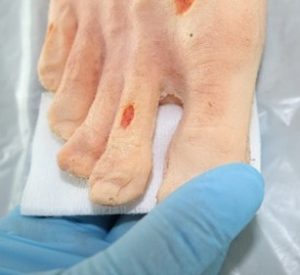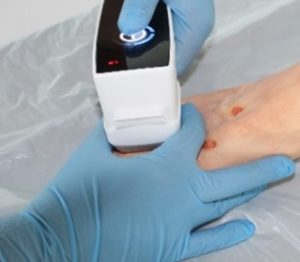The duration of therapy depends on the type, stress and history of the wound. An experienced wound care professional can see whether a wound is responding to the therapy after just 2-3 applications. Signs of this are, for example
- Better blood circulation in the wound
- Odor reduction
- Decrease in wound secretion
- Wound surface reduction
- Less pain when changing the dressing.
Regular follow-up treatment may be necessary for wounds such as amputation stumps that are exposed to heavy mechanical stress.
A wound area must be treated for at least 1 minute. Heavily contaminated wounds can be treated for up to 3 minutes per area. The duration also depends on the size of the wound. A maximum area of 70 – 78 cm² can be treated with one spacer, for which the plasma care must be applied 6 times for one minute, i.e. the treatment takes a total of 6 minutes.
Plasma can be used against all bacteria and also MRG. The wound care provider can see whether the wound reacts to the treatment after 2-3 treatments.
Cold plasma can be used on all wounds. The treatment of heavily bleeding wounds and wounds where the coatings cannot or must not be removed is not recommended, but would be possible in principle. Link to treatment spectrum.
As a general rule, the larger the surgical wound and the longer the procedure, the greater the risk of postoperative wound healing disorders.
Postoperative wounds respond excellently to cold plasma. In the case of postoperative wound healing disorders, treatment with cold plasma ensures healthy wound healing.
They heal significantly faster. This has been observed in particular in wounds in problematic areas that are exposed to high levels of stress and contamination.
If the treatment time of 3 minutes of a wound area is not exceeded, plasma does not affect healthy human cells.
Justification:
During treatment, the cell is exposed to oxidative stress. This stress is a positive stress that primarily stimulates the cell to reproduce and thus leads to cell renewal.
However, as the stress is short-term, it is not dangerous. No long-term free radicals are produced.
The pre-treatment (dressing change, wound toilet) is often painful. Patients have reported that this pain even subsides after a few cold plasma treatments.
Wound healing pain: There are very rare cases in which patients complain of pain after treatment. This pain is due to the activation of wound healing. The renewed activity of the wound is sometimes perceived as pain. However, the feeling usually subsides after a few treatments.
For neighboring wounds on the same part of the body: “Yes”, because the bacteria and germs spread to both wounds anyway.
In anatomically difficult areas (fingers/toes etc.), “enclose” the plasma care® spacer with your fingers or with the aid of compresses


It is essential that deep pockets and fistula tracts are tamponaded and kept open to prevent overgranulation. If this is not possible, cold plasma treatment should be avoided.
Around 120 treatments are possible with a fully charged battery. As the battery can discharge when not in use or when exposed to cold, we recommend placing the device in the charging station in the evening.
A superficial wipe disinfection should be carried out after each patient. The plasma source should only be cleaned if there is visible contamination.
A 3-minute movie is available to guide you through the cleaning process.



